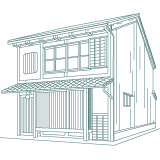Considerations Peculiar to Kyoto and Kyo-Machiya
- Traditional Wooden Structures
- All Kyo-machiyas are constructed in traditional wooden structures, which are completely different from modern structures in that there are no braces or metallic anchors; instead, the clasped wooden columns and beams are stabilized with mud walls. The houses constructed in traditional structures are now called “Existing Ineligible Buildings” as they were built before the Building Standards Act went into effect in 1950. For such houses, extension is rarely permitted while renovation and demolition are allowed. However, when more than 50% of a major structure becomes subject to renovation, the whole house must conform to the current Act.
- Earthquake Resistance of Renovated Kyo-Machiya
- When renovating Kyo-Machiyas, we reinforce and/or replace the structural elements such as columns and beams depending on the extent of damage. However, a reliable method of diagnosing earthquake resistance of Kyo-Machiyas has not been established due to their characteristics as a traditional antique wooden structure. Therefore, it is difficult to accurately measure its stability, and almost impossible for us to ensure that our Kyo-machiya properties meet the earthquake resistance standards. We ask buyers to understand the situation, and acknowledge the risk of possible collapse in the event of a severe earthquake.
- “Rebuilding Prohibited” Lands
- Rebuilding is not allowed on the lands marked as “Rebuilding Prohibited” because they do not meet legal standards of the current Building Standards Act. For example, most of the Kyo-machiyas located in narrow alleys are “Rebuilding Prohibited”. Even if an existing building collapses due to disasters such as a fire or an earthquake, rebuilding is not allowed on such lands.
- Liability for Defects
- As Kyo-Machiyas are traditional antique buildings constructed before 1950, they are not guaranteed against any known or predictable defects, and are handed over to the buyers in their current condition “as is”. For fully renovated properties whose seller is a real estate company, defects that are neither known nor predicted when handed over will be indemnified if the buyer lodges a claim within two years of the hand over.
- Borders
- The dimensions on the land registry maps sometimes do not accurately reflect the actual dimensions because the maps provided are used more for location identification than for border definition. Whenever possible, we place indication plates at each point of boundary corners, in the presence and upon agreement of the corresponding neighbors. This agreement is non-binding. We may fail to come to an agreement with some of the neighbors. It is in the innate nature of Kyo-Machiyas to have parts of the structures cross over into the neighboring properties (and vice versa), as most of them are originally terraced houses. We ask buyers to accept the situation, and acknowledge that in case of any conflict with the neighbors, it should be settled by discussion and negotiation between the buyer and the corresponding neighbors.
- Neighborhood Associations
- In Kyoto, it is a long-standing custom to organize a small community called “neighborhood associations” with neighbors. Almost every house in the city area belongs to one. The members share local information, hold small local festivals, or clean up around the neighborhood in rotation. The rules and the association fees vary depending on the association. Membership is voluntary, but it is important to understand the rules and customs among your neighbors.

 Find a Property
Find a Property